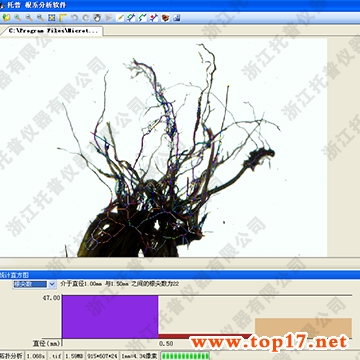Root analysis system classification introduction
The root analysis system can be divided into an in situ root image analyzer and a root image analyzer after root washing, depending on the imaging method. It is generally required to analyze the length, diameter, area, volume, number of root tips, number of branches, number of root crosses, etc. of the root system.

Some professional root analysis systems can also analyze the topological morphology, connection relationships, and color changes of the roots of the roots of the plant roots for the study of root morphology and structure. The latest root analysis system should have full-automatic analysis features of large batches of images. The user can perform partial interactive editing and correction of the automatic analysis results to ensure the scientificity of the data. For the in-situ root image, since the color of the root system and the soil may be very close to each other, the automatic enhancement of the root target in the image is adopted at home and abroad, and the marker analysis is performed in an interactive guidance manner. In addition, the introduction of fractal dimensions, as well as histogram projections for the analysis of root biomass as a whole. The latest technology of root analysis can also analyze the proportion of root nodule volume in the root system to objectively determine the contribution of rhizobia.
This set of root analysis system developed by Top Cloud Yunnong is a set of equipment currently used in the market. It can perform root color analysis, determine the number of root survivals, and output the diameter, length, projected area, surface area, and volume of different color roots. In addition, the system also has manual auxiliary correction: the image can be zoomed in and out and local observations; according to the difference in size and other aspects, automatic impurity rejection.
Tungsten Alloy For Oil Logging
Tungsten alloy is an ideal material for oil logging due to its high density, excellent corrosion resistance, and good mechanical properties. Oil logging is a process of measuring the porosity, permeability, and fluid content of rocks in the subsurface to evaluate the potential for oil and gas production.
Tungsten alloy is used in oil logging tools such as gamma ray detectors, density logging tools, and neutron porosity tools. These tools are used to measure the characteristics of the subsurface rock formations and determine the presence of oil and gas reserves.
The high density of tungsten alloy enables the tools to penetrate deep into the earth's crust and accurately measure the properties of the rock formations. Additionally, tungsten alloy is highly resistant to corrosion, which is critical in harsh environments such as oil fields.
Furthermore, tungsten alloy has excellent mechanical properties, including high strength and toughness, which make it suitable for use in downhole tools that are subjected to high pressure and temperature.
In summary, tungsten alloy is an ideal material for oil logging due to its high density, excellent corrosion resistance, and good mechanical properties. Its use in oil logging tools enables accurate measurement of subsurface rock formations and identification of potential oil and gas reserves.
Tungsten Alloy For Oil Logging,Rod For Oil Logging,Customization Tungsten Alloy Rods,Kinetic Energy Penetrator Tungsten Copper
Zhuzhou Jiuding Metal Technology Co., Ltd. , https://www.zztungstenheavyalloy.com